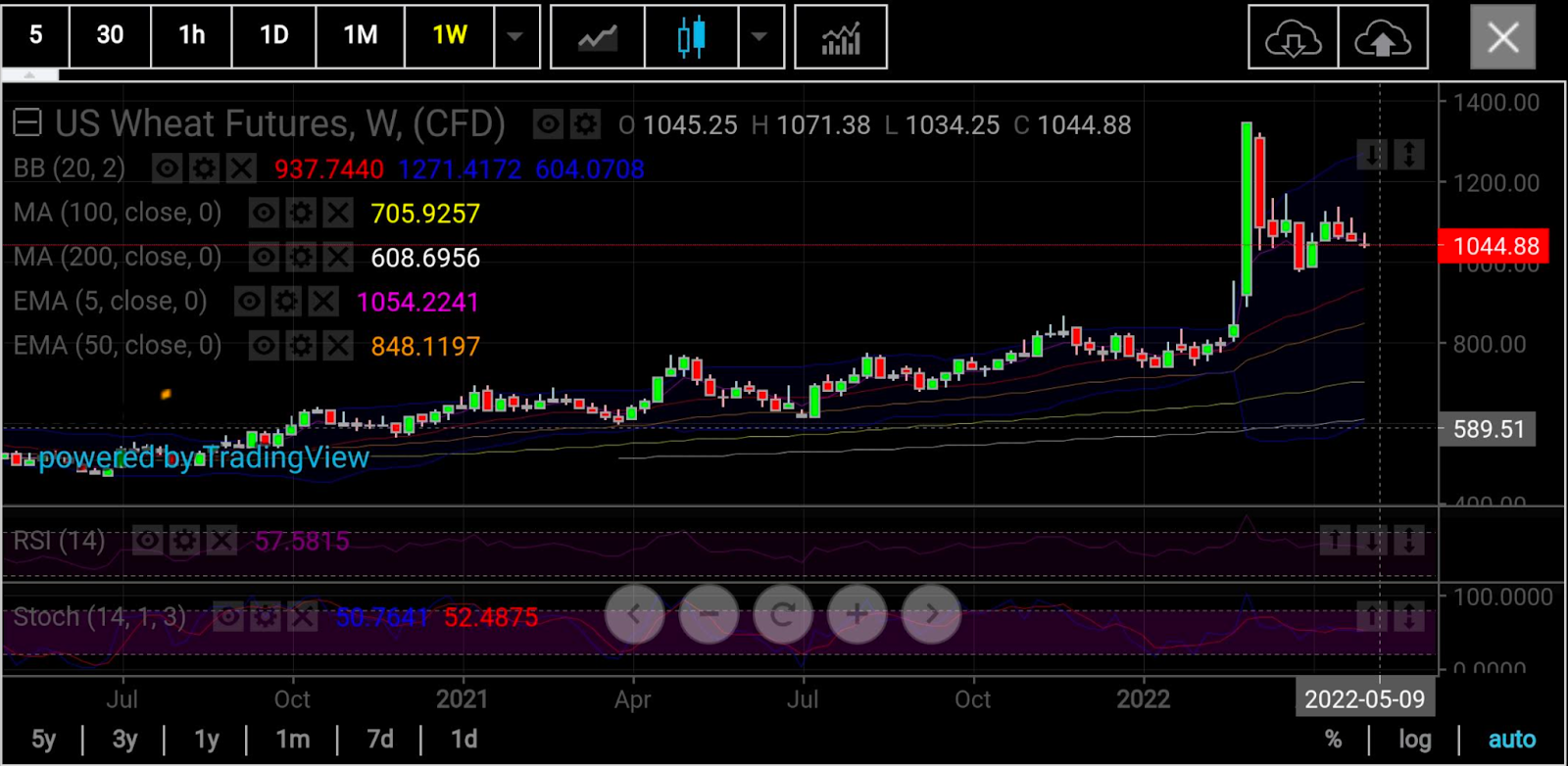Of all the non-energy commodities, wheat is probably one of the most political now. Its price and outlook are dependent on the outcome of the Ukraine war more than anything else.
And why not? Russia and Ukraine used to jointly supply nearly 30% of the world's wheat from vast and fertile farmlands in the Black Sea region known as the “bread basket of the world.” The war has certainly upended that, although all isn’t lost as exports from the region continue, albeit at a reduced and slower pace.
But as much as the sway that the political and fundamental narratives have on wheat, is there a technical story that’s just as important? It’s crucial to ask because US wheat futures are down 22% from the Mar. 4 peak of $13.40 per bushel, settling Tuesday on the Chicago Board of Trade at $10.47.
So, is wheat a buy now, technically, or has it more to lose?

All charts courtesy of skcharting.com
A look at CBOT’s wheat charts shows that its plunge began on the week ended Feb. 25, just ahead of the Mar. 4 peak, with the market logging six weeks in the red out of nine in total.
Sunil Kumar Dixit, chief technical strategist at skcharting.com, says the selloff may not be over based on the signals he’s seeing.
“A sustained break from the consolidation range is supposed to cause a $100-$200 move that could push wheat below the 50-Day Exponential Moving Average of $10.38 to the $9.70 low.”
“Further weakness can extend the correctional wave to horizontal support areas of $8.60 - $8.40.”
On the contrary, wheat was also exhibiting a tendency for a rebound, although this was more of a secondary signal, said Dixit.
“The daily stochastic reading of 10/14 calls for a short term reversal to between $10.60 and $10.80,” he said.
“The long and short of it is that wheat will be a wide range of $11.70 to $9.72.”

Fundamentally and politically as well, there’s a lot that can cause wheat prices to swing in the near term.
On Friday, the European Commission cut its forecast for the 2022/23 European Union wheat harvest, but maintained its projection for record EU exports as war disrupts supply from Ukraine.
In monthly cereal supply and demand estimates, the Commission cut its outlook for usable production of common wheat, or soft wheat, in the July 2022 to June 2023 season to 130.1 million tonnes from 131.3 million tonnes previously.
The new harvest forecast, which the Commission attributed to revisions for France and Sweden, was almost level with 2021/22 production of 130.0 million tonnes.
On Tuesday, CBOT wheat dropped to a three-week low of $10.52, falling for a sixth consecutive session, as showers in key growing parts of the US Plains provided a much needed boost to the crop.
“There are also reports of more Russian wheat offers into the world market,” said Jack Scoville, chief crop analyst at Chicago’s Price Futures Group.
“Russia has been offering into the world market at relatively cheap prices but the wheat is moving from the Black Sea, (and) a lot of ships are scared to go on those waters.”
Scoville noted that the wheat patch in the Western US Great Plains was too dry with poor crop conditions while the Ukraine conflict itself continued with little indication of a ceasefire—both providing support to the grain’s prices.
“Ports are closed in Ukraine but Russian shippers and exporters are offering and some sales are being reported at Black Sea ports, despite the high insurance costs associated with the boats coming into the sea,” he said.
“Ukraine can rail the exports to the EU for shipment but the amount that can be moved is very limited. Romania is taking some of the Ukrainian grain and shipping it.”

Meanwhile, continued fighting was disrupting the trade.
German Agriculture Minister Cem Ozdemir said on Monday, Kyiv could lose tens of millions of tonnes of grain due to Russia's blockade of its Black Sea ports, adding that Moscow attacks on Ukraine's grain infrastructure look like attempts to reduce competition to Russia's export markets.
According to Germany's Federal Office for Economic Affairs and Export Control, Ukraine's wheat production accounts for 11.5% of the world market, while Russia's share is 16.8%.
“We are repeatedly receiving reports about targeted Russian attacks on grain silos, fertilizer stores, farming areas and infrastructure,” Ozdemir was quoted as telling the RedaktionsNetzwerk Deutschland, a cooperation network of German regional newspapers.
There is also speculation that President Vladimir Putin could use May 9, known as Russia’s "Victory Day" commemorating its 1945 defeat of the Nazis, as an occasion to heighten the offensive against Ukraine. So far, Putin has taken to calling the invasion a “special military operation” to disarm Ukraine. May 9 might give Russia the opportunity to change the description to a “war” that would legitimize more aggression against its neighbor, those in the know said.
Disclaimer: Barani Krishnan uses a range of views outside his own to bring diversity to his analysis of any market. For neutrality, he sometimes presents contrarian views and market variables. He does not hold a position in the commodities and securities he writes about.
